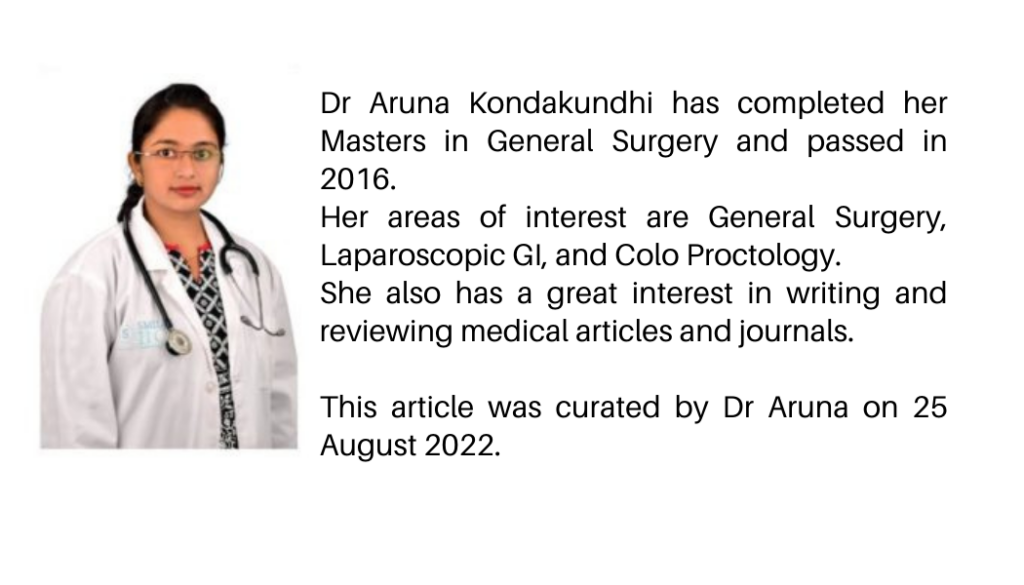Anal Fissure
An anal fissure occurs as a small tear or cut in the inside of the anus’s lining. The skin crack can cause severe pain, as well as bright red bleeding that occurs during and after bowel movements. The fissure can sometimes be deep enough to expose the muscle tissue underneath. Read More
Top Doctors For Anal Fissure Treatments
Top Hospitals For Anal Fissure Treatments
Anal Fissure
Table of contents
What is an anal fissure?
An anal fissure occurs as a small tear or cut in the inside of the anus’s lining. The skin crack can cause severe pain, as well as bright red bleeding that occurs during and after bowel movements. The fissure can sometimes be deep enough to expose the muscle tissue underneath.
Usually, anal fissures are not very serious conditions. It affects anyone of any age and is often experienced by infants and younger children due to constipation being the most frequent complaint within these age ranges.
In the majority of cases, tears heal in their own time, usually within four to six weeks. If the fissure continues to persist for more than the period of eight weeks, this is considered to be chronic. Certain treatments may promote healing and ease discomfort, for example, stool softeners and topical pain relieving agents.
If an anal fissure doesn’t improve with these treatments, then the patient may need surgery. Or the doctor may need to look for other underlying disorders that can cause anal fissures.
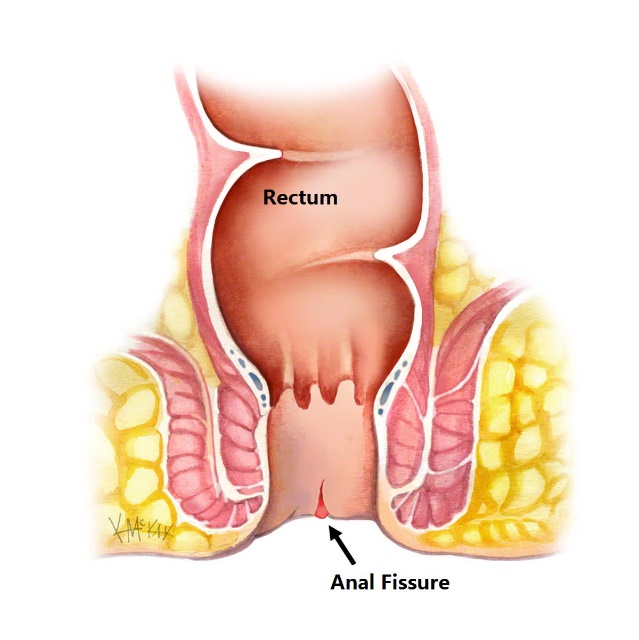
Causes
An anal fissure is typically experienced when passing large or hard stools. Constipation that is frequent or chronic can cause skin irritation around the anus. Other common causes include:
- straining during childbirth or bowel movements
- inflammatory bowel disease (IBD), such as Crohn’s disease
- decreased blood flow to the anorectal area
- overly tight or spastic anal sphincter muscles
In rare instances, the anal fissure could occur due to anal cancer, syphilis, tuberculosis, HIV, and herpes.
Symptoms

Anal fissures may trigger one or more of these symptoms:
- a visible tear in the skin around the anus
- A skin tag, or a small piece of skin close to the tear
- there is a sharp pain felt in the anus during bowel movements
- Blood streaks on stools, or tissue paper, after wiping
- burning or itching in the anal area
FAQ
An anal fissure is a tear or ulcer in the lower thin, and delicate lining of the anal canal occurring in the midline mainly situated in the backside (posteriorly than anterior), which is common in the middle age group of 20-40 yrs with no sex predilection.
It is of two types Acute and Chronic. An acute anal fissure is a deep tear with a spasm of the anal sphincter, which presents with severe pain associated while passing stool constipation. Chronic fissure lasts for more than 6 weeks less painful than acute, and is generally accompanied by inflammation, skin tag, and ulcer.
Anal fissure does not cause death. It can cause discomfort for an extended time and cause complications like abscess and fistula formation. Still, misdiagnosis as an anal fissure of other medical conditions can prove fatal.
The most common cause of anal fissure is passing hard stools, which injures the lining of the anal canal. Also, diarrhea, on the other hand, can lead to the development of anal fissures. Other causes include increased sphincter tone, local interrupted blood supply, sexually transmitted disease, Anal sex and other local trauma, Hemorrhoids, Crohn’s disease, tuberculosis, ulcerative colitis, etc. 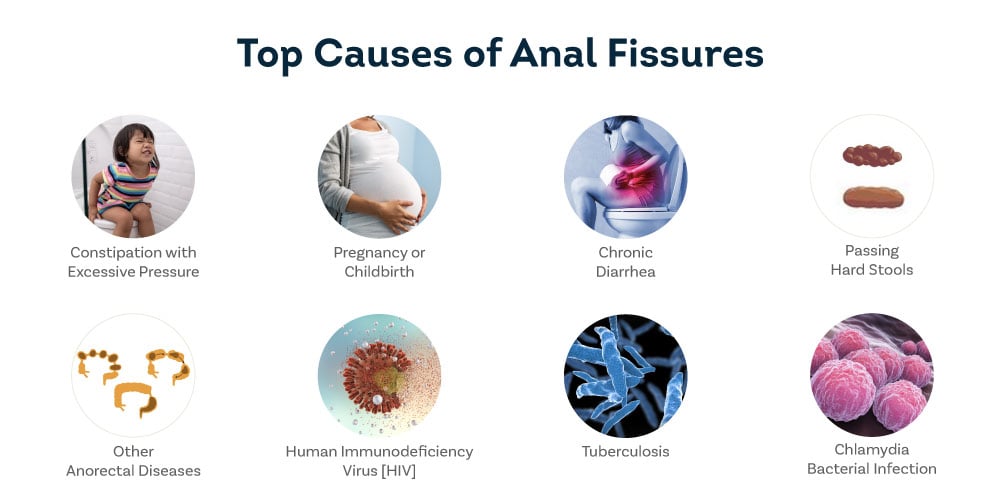
Picture Courtesy: lifeline
Anal fissure causes pain and discomfort while passing stools which may include passing blood in the stools, constipation, itching secondary to irritation, and discharge from the wound.
Efforts should be made to avoid constipation or soften the stools to decrease pain while passing stool or to prevent the advancement of the disease, which include
a) Adequate water intake (6-8 glasses of fluid)
b) Addition of fiber-rich substances to diet like whole grain, fruits like pear, orange, melon.
c) Bulk-forming agents like husk, bran.
d) Having healthy stool habits and avoiding straining while passing stools.
e) Also, treatment of accompanied diarrhea should be done.
It can lead to the development of Anal abscess formation(which is an infected ulcer) and subsequent fistula formation. Chronic cases are usually associated with anal tags, which further add to the discomfort and can cause blood collection. Recurrence is also considered to be one of the complications of anal fissures. 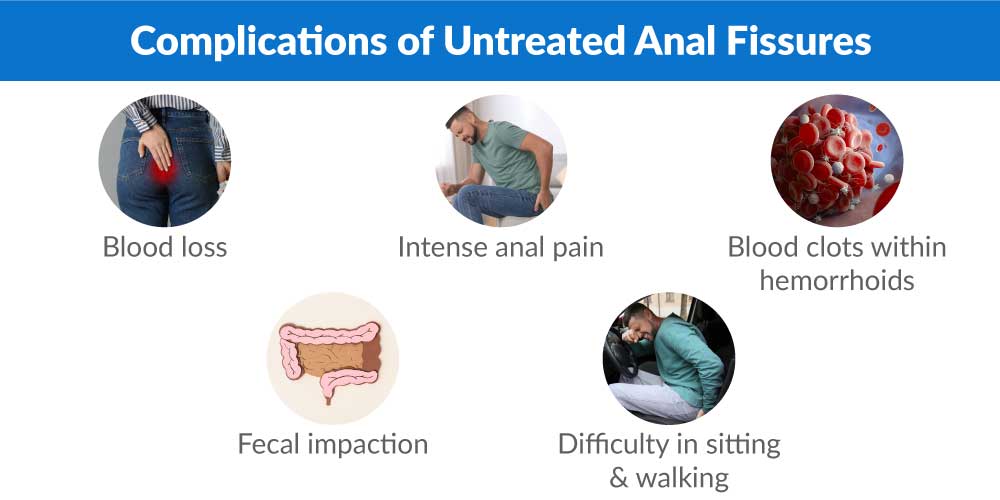
Picture Courtesy: lifeline
An anal fissure can be done initially based on the symptoms told by the patient, followed by
1) Physical examination: During a physical examination, the doctor gently separates the buttocks allowing for visual inspection of the region around the anus. A fissure generally appears around 6 or 12 o’clock positions.
2) Digital rectal examination: During this examination, the doctor gently inserts gloved fingers inside the anus and checks for any signs of abnormalities
3) Anoscopy: During this procedure, a small instrument is inserted to view the anal canal.
4) Flexible sigmoidoscopy: During this procedure, a thin, flexible tube is placed along with a camera into the last part of the colon to look for the cause of the anal fissure.
5) Colonoscopy: It is the same as sigmoidoscopy, while it is useful to view the entire colon.
One should not hesitate to see General Surgeon
1) If the pain and discomfort are not getting better after taking general measures.
2) Pain or discomfort gets worse or if the stool contains blood
3) Condition isn’t getting better even after 6 weeks of treatment.
Conservative treatment is aimed to eliminate the cause, which is to soften the stools, which includes adequate water intake, stool softener, and a fiber-rich diet. One can practice a Sitz bath which includes sitting in warm water 2-3 times a day for about 15-20minutes to relax the sphincter or to increase blood flow and hasten healing.
Local application of lignocaine numbs the area, relaxes the sphincter, and decreases pain. The doctor may prescribe drugs like Diltiazem (two times a day) or other Calcium channel blockers, Glyceryl trinitrate, two or three times a day. Self-medication is harmful. Other medications include externally applied nitro-glycerine to help increase blood flow to the fissure and improve healing of the wound and help relax the anal sphincter.
Surgical treatment is advocated when medical treatment fails, or the patient is at risk of complications.
Dorsal fissurectomy with sphincterotomy is done (removal of fissure and incision of sphincter).
Lateral anal sphincterotomy consists of dividing the internal sphincter on either the right or left side. It has a 90% success rate unless there are chances of reoccurrence.
Anal Advancement flap is a newer method implied generally in females and those with lower normal resting anal pressure. Edges of the fissure are excised, and skin overlying the sphincter is mobilized over the blood supply.
For acute cases stretching with a finger under local anesthesia to relax the sphincter can be implied.
An anal fissure can also be treated by minimally invasive surgery using a laser.
Patients are generally maintained on stool softeners, bulking agents, and topical sphincter relaxants.
The complication of surgery includes hematoma formation, perianal bruising, fistula, and incontinence.
The patient generally gets discharged on the same day or within 24-48 hours as it is a daycare surgery.
Diltiazem causes headache and dizziness, so the patient needs to inform about their medical conditions and the medications they are taking.
The patient can perform all activities after surgery. No activities are contraindicated.
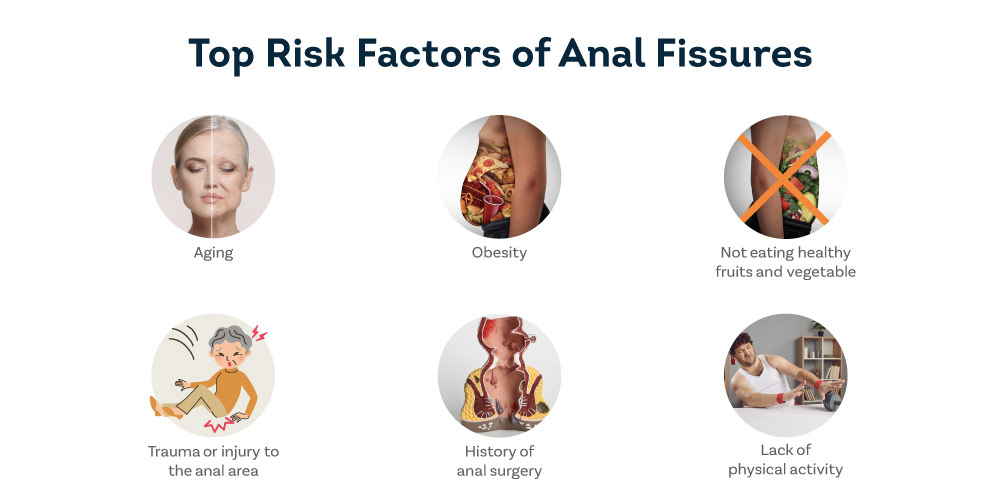
Picture Courtesy: lifeline
Anal fissures can be prevented by taking measures to avoid constipation or diarrhea. Maintaining a healthy lifestyle, adding more fiber to the diet, drinking plenty of fluids, exercise regularly in order to prevent straining during bowel movements.
